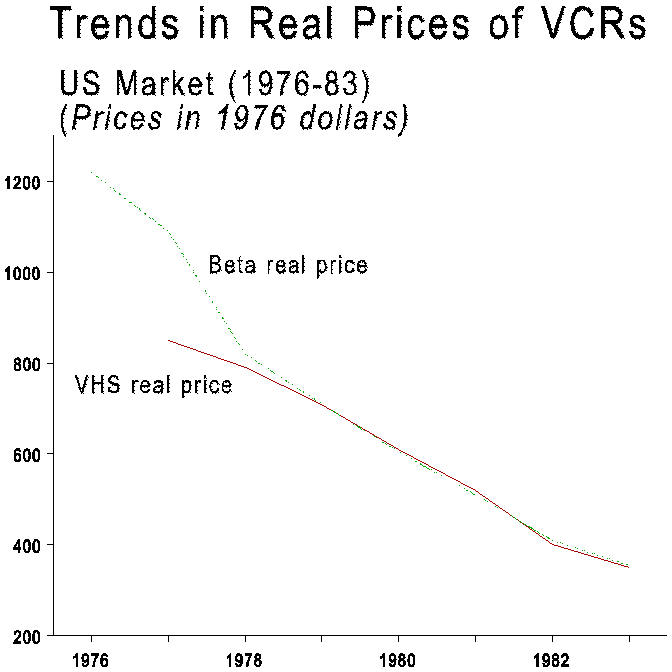
(or which exchange risk do you want to cover?)
In January 1982 Bill Straub, the finance manager of the Video Tape Recorder division of the company was confronted with a nasty dilemma: what to do with a big chunk of yen payables that his unit accumulated in the course of its business which consisted of marketing a line of video tape recorders under the G.E. label in the United States. Like all video tape recorders sold in the U.S. market, G.E.'s were also made in Japan by one of the four manufacturers that dominate the business and its associated technology. Steady advances in that technology and production processes had put VCR prices on a long term downward trend of approximately 12 percent p.a., a trend that was expected to continue (see Figure). The four Japanese manufacturers sold machines under their own labels, but they also supplied U.S. marketers who sold them under their own names, and G.E. was one of them. Because the Japanese manufacturers had the field all to themselves, they invoiced their customers in yen, giving customarily 90 day terms.
Bill Straub's dilemma was in part accentuated by the conditions on the distribution side of the video tape recorder business: there were about ten competitors active in the U.S. market, including the four captive marketing companies of the Japanese manufacturers. During the recession, demand for video tape recorders had slowed considerably as consumers' buying intentions had weakened. As a result of soft demand and intense competition, margins were razor thin. In this environment, hedging costs began to matter. To make things worse, they were at a record high: the yen had weakened a bit over the past months from Y242 per U.S. dollar to Y250. Ninety-day forwards at this time ran at Yen 246, reflecting approximately a 6.5 percent U.S. dollar premium to Yen when converted to an annual basis. The cost of U.S. dollar debt at the time was 15.5 percent, while rates for "Euroyen" (yen credits available from banks outside of Japan) were about 9 percent per annum.
In 1981, Bill's strategy of leaving the payables uncovered had turned
out to be a brilliant tactical move. Not only had the dollar value of the
yen decreased, Bill's action saved the division also 6.5 percent hedging
costs per annum, as he was careful to point out in his annual report. But
now for 1982, what was he going to do as an encore? Bill recognized that
the same superiors who patted him on the back for his success, would sacrifice
him without mercy if the yen turned the wrong way. As long as that currency
would appreciate by no more than four yen for every 90 days, Bill could
always argue that the hedging cost savings equalled roughly the translation
losses. However, a glance at the historical evidence told him that the
Japanese currency was given to abrupt swings and Bill was not sure whether
this was not the time when caution was the better part of valor.

Since any hedging strategy would represent a major change in financial policy for the division, Bill recognized that he had to do some selling inside. In particular, the people that mattered had to be told about the accounting and cash flow implications as well as the various hedging alternatives.
Could you help Bill prepare his presentation?